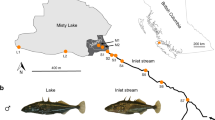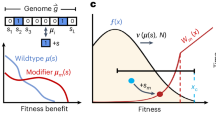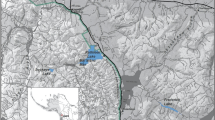Summary
Theoretical studies of the rate of fixation of null alleles at duplicate loci were carried out with both deterministic numeric analysis and computer simulations assuming an intermediate selective optimum of the number of active gene copies. A relatively rapid loss of duplicate gene expression occurs with this model under a wide variety of conditions, including incomplete recessiveness of the null allele and linkage. It differs from previous models of gene loss, which are based on mutation pressure, because the rate of gene loss is accelerated with increasing population size. Identification of the mode of selection responsible for the observed loss of gene duplication in polyploid fish is not possible at present. It appears, however, that the loss of duplicate gene expression occurs shortly following duplication. Once some structural or regulatory genetic divergence occurs, the duplicated loci become relatively stable.
Similar content being viewed by others
Article PDF
References
Allendorf, F W. 1978. Protein polymorphism and the rate of loss of duplicate gene expression. Nature, 272, 76–78.
Andrews, K J, and Hegeman, G D. 1976. Selective disadvantage of non-functional protein synthesis in Escherichia coli. J Mol Evol, 8, 317–328.
Avise, J C, and Kitto, G B. 1973. Phosphoglucose isomerase gene duplication in the bony fishes: an evolutionary history. Biochem Genet; 8, 113–132.
Bailey, G S, Pulter, R T M, and Stockwell, P A. 1978. Gene duplication in tetraploid fish: model for gene silencing at unlinked duplicated loci. Proc Nat Acad Sci USA, 75, 5576–6579.
Baker, W K. 1975. Linkage disequilibrium over space and time in natural populations of Drosophila montana. Proc Nat Acad Sd USA, 72, 4095–4099.
Engel, W, Schmidtke, J, and Wolf, U. 1975. Diploid-tetraploid relationships in teleostean fishes. In Isoymes, Vol. IV: Genetics and Evolution, ed. C. L. Markert. Academic Press, New York.
Ferris, S D, and Whitt, G S. 1977a. Loss of duplicate gene expression after polyploidisation. Nature, 265, 258–260.
Ferris, S D, and Whitt, G S. 1977b. Duplicate gene expression in diploid and tetraploid loaches (Cypriniformes, Cobitidae). Biochem Genet, 15, 1097–1112.
Fincham, J R S. 1972. Heterozygous advantage as a likely general basis for enzyme polymorphisms. Heredity, 28, 387–391.
Fisher, R A. 1935. The sheltering of lethals. Amer Natur, 69, 446–455.
Fisher, S E, and Whitt, G S. 1978. Evolution of isozyme loci and their differential tissue expression. J Mol Evol, 12, 25–55.
Gelbart, W, McCarron, M, and Chovnick, A. 1976. Extension of the limits of the XDH structural element in Drosophila melanogaster. Genetics, 84, 211–232.
Grant, V. 1971. Plant Speciation. Columbia University Press.
Haldane, J B S. 1933. The part played by recurrent mutation in evolution. Amer Natur, 67, 5–19.
Harris, H. (in press). Multi-locus enzymes in man. CIBA Foundation Symposium, No. 66 (new series).
Hartley, B S. 1974. Enzyme families. In Evolution in the Microbial Worlds, eds. M. J. Carlile and J. J. Skehel. Cambridge University Press.
Hartley, B S, Altosaar, I, Dothie, J M, and Neuberger, M S. 1976. Experimental evolution of a xylitol dehydrogenase. Proc Third John Innes Symp, 191–200.
Karlin, S, and McGregor, J. 1971. On mutation selection balance for two-locus haploid and diploid populations. Theoret Pop Biol, 2, 60–70.
Kimura, M, and King, J L. (in press). Fixation of a deleterious allele at one of two “duplicate” loci by mutation pressure and random drift. Proc Nat Acad Sci USA
Koch, A L. 1972. Enzyme evolution. I. The importance of untranslatable intermediates. Genetics, 72, 297–316.
Latter, B D H. 1975. Enzyme polymorphisms: gene frequency distributions with mutation and selection for optimal activity. Genetics, 79, 325–331.
Levin, D A, Torres, A M, and Levy, M. 1979. Alcohol dehydrogenase activity in diploid and autotetraploid Phlox. Biochem Genet, 17, 35–42.
Markert, C L, Shaklee, J B, and Whitt, G S. 1975. Evolution of a gene. Science, 189, 102–114.
Nei, M, and Roychoudhury, A K. 1973. Probability of fixation of non-functional genes at duplicate loci. Amer Natur, 107, 362–372.
Ohno, S. 1974. Protochordata, fyclostomata, and Pisces. Gebrüder-Borntraeger, Stuttgart.
Roberts, R M, and Baker, W K. 1973. Frequency distribution and linkage disequilibrium of active and null esterase isozymes in natural populations of Drosophila montana. Amer Natur, 107, 709–726.
Schwartz, M, and Sofer, W. 1976. Alcohol dehydrogenase-negative mutants in Drosophila: defects at the structural locus. Genetics, 83, 125–136.
Simmons, M J, and Crow, J F. 1977. Mutations affecting fitness in Drosophila populations. Ann Rev Genet, 11, 49–78.
Takahata, N, and Maruyama, T. (in press). Polymorphism and loss of duplicate gene expression: theoretical study and its applications. Proc Nat Acad Sci USA
Wallace, B. 1966. Distance and the allelism of lethals in a tropical population of Drosophila melanogaster. Amer Natur, 100, 565–578.
White, M J D. 1978. Modes of Speciation. W. H. Freeman, San Francisco.
Wright, S. 1964. Pleiotropy in the evolution of structural reduction and of dominance. Amer Natur, 98, 65–69.
Acknowledgements
Acknowledgments.-I thank Professor Bryan Clarke for his suggestions and for providing facilities during my stay in the Genetics Research Unit, Bill Dunlap for commenting on the manuscript, and Drs M. Kimura and N. Takahata for kindly providing me with preliminary copies of their papers. I also thank Dr David Parkin of the Genetics Department and the staff of the Cripps Computer Center for generously providing the facilities and time to complete the simulations presented here. This work was done while I was supported by a NATO Fellowship from the National Science Foundation.
Author information
Authors and Affiliations
Rights and permissions
About this article
Cite this article
Allendorf, F. Rapid loss of duplicate gene expression by natural selection. Heredity 43, 247–258 (1979). https://doi.org/10.1038/hdy.1979.80
Received:
Issue date:
DOI: https://doi.org/10.1038/hdy.1979.80
This article is cited by
-
Phenotypic polymorphism for superoxide dismutase in grape
Euphytica (1996)
-
Isozyme polymorphism ofβ-glucosidase inAspergillus nidulans
Biochemical Genetics (1988)
-
Isozyme polymorphism of?-glucosidase inAspergillus nidulans
Biochemical Genetics (1988)
-
Developmental rate and viability of rainbow trout with a null allele at a lactate dehydrogenase locus
Biochemical Genetics (1988)
-
Phosphoglucose isomerase (EC 5.3.1.9) isozymes in diploid and tetraploid Polygala species: evidence for gene duplication and diversification
Heredity (1986)



